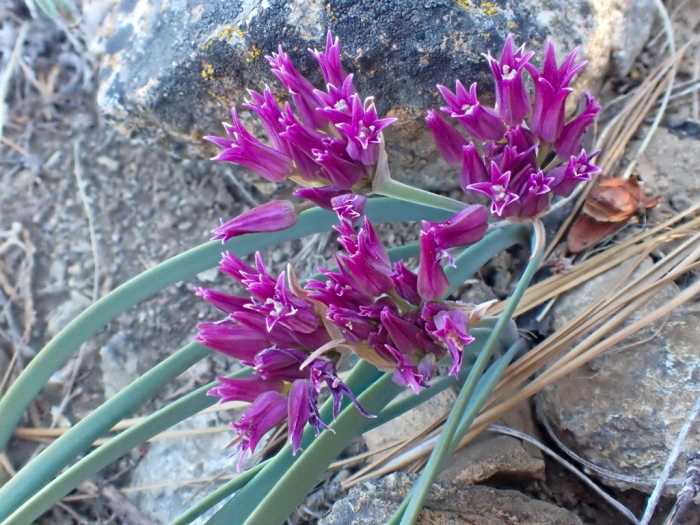Scytheleaf Onion
(Allium falcifolium)
Scytheleaf Onion (Allium falcifolium)
/
/

© Chloe and Trevor Van Loon
CC BY 4.0
Image By:
© Chloe and Trevor Van Loon
Recorded By:
Copyright:
CC BY 4.0
Copyright Notice:
Photo by: © Chloe and Trevor Van Loon | License Type: CC BY 4.0 | License URL: http://creativecommons.org/licenses/by/4.0/ | Uploader: chloe_and_trevor | Publisher: iNaturalist |
























Estimated Native Range
Summary
Allium falcifolium, commonly known as Scytheleaf Onion or Coast Flatstem Onion, is a perennial herb native to chaparral, coastal sage scrub, and open woodlands of northern California and southern Oregon. It thrives in heavy, rocky soils, particularly serpentine soils, which are often nutrient-poor and harsh for many other plant species. This species typically grows to a height of 10-40 centimeters. The plant features narrow, curved, scythe-like leaves that give it its common name. From late spring to early summer, it produces an umbel of striking flowers that can be pinkish, red-purple, or white-streaked, which are quite showy and attract pollinators.
Scytheleaf Onion is valued for its ornamental flowers and its ability to adapt to difficult soil conditions, making it a suitable choice for rock gardens, native plant gardens, and ecological restoration projects. It requires minimal maintenance once established, needing only occasional water in extremely dry conditions. In cultivation, it prefers full sun to part shade and well-drained soils. While it is not commonly affected by diseases, it can be susceptible to root rot if overwatered or planted in poorly draining soils. It is not known to be invasive and does not have aggressive roots, making it a safe choice for most garden settings.CC BY-SA 4.0
Scytheleaf Onion is valued for its ornamental flowers and its ability to adapt to difficult soil conditions, making it a suitable choice for rock gardens, native plant gardens, and ecological restoration projects. It requires minimal maintenance once established, needing only occasional water in extremely dry conditions. In cultivation, it prefers full sun to part shade and well-drained soils. While it is not commonly affected by diseases, it can be susceptible to root rot if overwatered or planted in poorly draining soils. It is not known to be invasive and does not have aggressive roots, making it a safe choice for most garden settings.CC BY-SA 4.0
Plant Description
- Plant Type: Herb, Bulb
- Height: 0.3-0.6 feet
- Width: 0.25-0.3 feet
- Growth Rate: Moderate
- Flower Color: Pink, Purple, White
- Flowering Season: Spring, Summer
- Leaf Retention: Deciduous
Growth Requirements
- Sun: Full Sun, Part Shade
- Water: Low, Medium
- Drainage: Fast, Medium
Common Uses
Bee Garden, Butterfly Garden, Low Maintenance, Rock Garden
Natural Habitat
Native to chaparral, coastal sage scrub, and open woodlands
Other Names
Common Names: Sickle-leaved Onion
Scientific Names: , Allium falcifolium, Allium breweri, Allium falcifolium var. breweri,
GBIF Accepted Name: